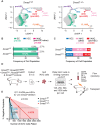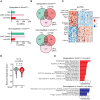This is a preprint.
Restraint of TGFβ family signaling by SMAD7 is necessary for hematopoietic stem cell maturation in the embryo
- PMID: 40909562
- PMCID: PMC12407734
- DOI: 10.1101/2025.08.23.671940
Restraint of TGFβ family signaling by SMAD7 is necessary for hematopoietic stem cell maturation in the embryo
Abstract
Hematopoietic stem cells (HSCs), defined as cells that can engraft an adult when transplanted, mature from precursors (pre-HSCs) that differentiate from hemogenic endothelial cells (HECs) in the embryo. Many signaling pathways required to generate the first hematopoietic stem and progenitor cells in the embryo are well-characterized, but how HSCs mature from pre-HSCs is poorly understood. Here we show that "mothers against decapentaplegic homolog 7" (SMAD7), a negative regulator of transforming growth factor beta (TGFβ) and bone morphogenetic protein (BMP) signaling, is required for pre-HSC to HSC maturation. Deletion of Smad7 in endothelial cells allows the formation of pre-HSCs from HECs but impairs their maturation into HSCs. The data indicate that although TGFβ and BMP signaling are required for the generation of HECs and for HECs to undergo an endothelial-to-hematopoietic transition to generate pre-HSCs, one or both pathways must be subsequently down-regulated for effective pre-HSC to HSC maturation.
Keywords: SMAD7; TGFβ signaling; hematopoietic stem cells; pre-HSCs.
Figures






Similar articles
-
Prescription of Controlled Substances: Benefits and Risks.2025 Jul 6. In: StatPearls [Internet]. Treasure Island (FL): StatPearls Publishing; 2025 Jan–. 2025 Jul 6. In: StatPearls [Internet]. Treasure Island (FL): StatPearls Publishing; 2025 Jan–. PMID: 30726003 Free Books & Documents.
-
Short-Term Memory Impairment.2024 Jun 8. In: StatPearls [Internet]. Treasure Island (FL): StatPearls Publishing; 2025 Jan–. 2024 Jun 8. In: StatPearls [Internet]. Treasure Island (FL): StatPearls Publishing; 2025 Jan–. PMID: 31424720 Free Books & Documents.
-
Tetraspanin CD82 regulates transforming growth factor-β signaling in hematopoietic stem and progenitor cells.Mol Biol Cell. 2025 Jul 1;36(7):br19. doi: 10.1091/mbc.E24-10-0474. Epub 2025 May 28. Mol Biol Cell. 2025. PMID: 40434872
-
Regulation of HSC development and function by Lin28b.Front Cell Dev Biol. 2025 Mar 12;13:1555877. doi: 10.3389/fcell.2025.1555877. eCollection 2025. Front Cell Dev Biol. 2025. PMID: 40143971 Free PMC article. Review.
-
Sickle Cell Disease.2003 Sep 15 [updated 2025 Feb 13]. In: Adam MP, Feldman J, Mirzaa GM, Pagon RA, Wallace SE, Amemiya A, editors. GeneReviews® [Internet]. Seattle (WA): University of Washington, Seattle; 1993–2025. 2003 Sep 15 [updated 2025 Feb 13]. In: Adam MP, Feldman J, Mirzaa GM, Pagon RA, Wallace SE, Amemiya A, editors. GeneReviews® [Internet]. Seattle (WA): University of Washington, Seattle; 1993–2025. PMID: 20301551 Free Books & Documents. Review.
References
-
- Palis J., Robertson S., Kennedy M., Wall C., and Keller G. (1999). Development of erythroid and myeloid progenitors in the yolk sac and embryo proper of the mouse. Development 126, 5073–5084. - PubMed
Publication types
Grants and funding
LinkOut - more resources
Full Text Sources
